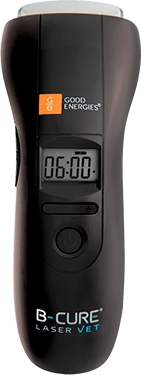Hip Arthritis & Dysplasia
Watch the 3-min video treatment guide:
Hip Dysplasia is an abnormal formation of the hip socket that can eventually cause crippling lameness and painful arthritis of the joints in its more severe form. It’s common in many dog breeds, particularly the larger breeds, and is the leading cause of arthritis of the hips. It is a genetic (polygenic) trait affected by environmental factors.
During growth, the ball (the head of the femur or thighbone) and the socket in the pelvis must grow at equal rates. In hip dysplasia, this consistent growth during puppyhood does not occur. The result is laxity of the joint, followed by degenerative joint disease (DJD) or osteoarthritis (OA), which is the body’s attempt to stabilize the loose hip joint.
Causes and effects
Hip dysplasia occurs by a femur that does not fit correctly into the pelvic socket, or muscles that were developed poorly in the pelvic area. Due to their BMI, large and giant breeds are most susceptible to hip dysplasia, though many other breeds can suffer from it.
To reduce pain, the animal will typically reduce the movement of that hip. It may be visible as “bunny hopping”, where both legs move together, or less dynamic movement (running, jumping), or stiffness. Since the hip cannot move fully, the body compensates by adapting its use of the spine, often causing spinal, stifle (a dog’s knee joint), or soft tissue problems to arise.
The causes of hip dysplasia are considered heritable, but new research conclusively suggests that the environment also plays a role. Neutering a dog, especially before the dog has reached an age of full developmental maturity, has been proven to almost double the chance he or she will develop hip dysplasia versus intact dogs or dogs that were neutered after reaching adulthood.
Other environmental influences include:
- Overweight condition.
- Injury at a young age.
- Overexertion on the hip joint at a young age.
- Ligament tear at a young age.
- Repetitive motion on forming joint (i.e., jogging with a puppy under one).
As current studies progress, more significant information may help provide procedures to effectively reduce this condition.
The problem almost always appears when the dog is 18 months old. The defect can be mild to severely crippling and can eventually cause severe osteoarthritis. It is most common in medium-large purebred dogs, such as Newfoundlands, German Shepherd Dogs, retrievers (such as Labradors, Tollers, or Goldens), Rottweilers, and Mastiffs, but also occurs in some smaller breeds such as spaniels and pugs.
Symptoms
- Decreased activity
- Decreased range of motion
- Difficulty or reluctance rising, jumping, running, or climbing stairs
- Lameness in the hind end
- Looseness in the joint
- Narrow stance
- Swaying, “bunny hopping” gait
- Grating in the joint during movement
- Loss of thigh muscle mass
- Noticeable enlargement of the shoulder muscles as they compensate for the hind end
- Pain
- Stiffness or soreness after rising from rest
- Subluxation or dislocation of the hip joint
Methods of Treating Hip Dysplasia:
- Maintenance of minimal body weight
- Limited exercise routine
- Physical therapy
- Medication
- Surgery
- Knee pain treatment with low-level laser: B-Cure Laser Vet
“B-Cure Laser Vet is an effective mode of treatment that helps treat inflammation, reduces pain and swelling.”
B-Cure Laser Vet provides breakthrough laser therapy, offering the power of professional lasers as used in clinics, in a lightweight portable device that can be used from the comfort of home.
No medications are required, the treatment is safe, effective, and provides lasting pain relief.
B-Cure Laser’s restorative power is provided by advanced laser technology.
B-Cure Laser is placed in contact with the skin allowing the photon energy to penetrate the tissues. This stimulates the body to produce adenosine triphosphate otherwise known as ATP, which carries energy within the cells. The ATP interacts with various biomolecules inside the cells promoting normal cell function and enhancing the body’s natural healing processes.
Therapeutic effects of LLLT (laser phototherapy) include:
- Increased production of ATP (Adenosine Triphosphate)
- Increased cellular metabolism
- Increased collagen production
- Increased enzyme production
- Increased protein synthesis
- Improved blood circulation
- Improved lymphatic flow and drainage
- Reduced inflammation
All this serves to boost the body’s natural healing power, targeting the root causes of pain and providing rapid relief.
B-Cure Laser is unique with a beam that covers a surface of 4.5 cm, making it possible to treat a wide range of painful conditions easily, effectively and quickly.
B-Cure Laser is now available for home use and has been proven clinically effective and safe. The treatment has no known side effects and is a natural and non-invasive method for treating many types of orthopedic conditions.
B-Cure Laser is safe, does not harm the eyes, and there is no need for protective eyewear during use.
What Are the Benefits of B-Cure Laser?
- Accelerates healing and reduces chronic pain
- Reduces pain, inflammation, and the consumption of drug therapy
- Non-invasive and non-surgical treatment
- No side effects
- Clinically proven
- Easy and safe for home use
To treat hip arthritis and hip dysplasia start with a dosage of 1.5 minutes on each of the spots shown below and gradually increase the duration of the treatment up to 4 minutes within 24 hours.
In order to reach optimal results, repeat the treatment at least twice a day.




